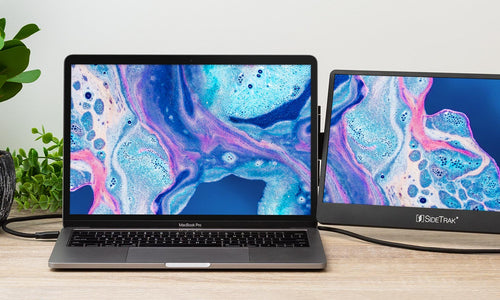Tech Specs 101: Refresh Rate vs. Response Time
If you're shopping for a new computer monitor, TV, or laptop, you'll find yourself staring down endless lists of tech specs as you try to make your decision. From image quality to viewing angles to loading speed, understanding what these tech specs mean and in which circumstances they truly matter is integral to getting the right screen to meet your day-to-day needs.
In this kickoff post for SideTrak’s new Tech Specs 101 blog series, we’ll highlight the key features of refresh rate and response time, including what they are, why they matter, and the use cases where they really make a difference.
Frames Per Second
Before we examine either of these specs, it's essential first to understand frames per second, or FPS.
Start by thinking of a flipbook, wherein you draw one small image on each page. Each subsequent page shows that image making a tiny movement. Flipping the pages of the entire book creates continuous action, with each individual drawing providing the details of the overall movement.
The same thing happens on your screen—still frames (pages) are perpetually loaded and displayed, combining to produce a movie or game. Each program your computer's processor runs has a maximum number of these frames available to be played per second, hence frames per second.
Super fast action games have more FPS, whereas most day-to-day videos and programs have fewer FPS. How your monitor handles the available FPS depends on its refresh rate and response time.
Refresh Rate
Refresh rate is the number of times per second the display on a screen is refreshed, and it's measured in Hertz (Hz).
Revisiting the flipbook metaphor, a faster refresh rate shows each existing flipbook page, whereas a slower refresh rate effectively “skips” pages.
For example, a refresh rate of 144 Hz vs. 60 Hz would be like flipping an additional 84 pages each second. At 60 Hz, you still see the overall action of the image making its movement, but since some pages are skipped, a small amount of detail is missed. However, that detail is only missed if it existed in the first place, which is contingent on the number of initial FPS.
So, How Important is the Refresh Rate?
As a reference, the standard for movies is just 24 frames per second. So, for most users, a refresh rate of 60 Hz displays everything necessary to stream movies, edit photos and videos, and load a company-wide online meeting. Most high-quality laptop screens and computer monitors have a refresh rate of 60 Hz.
Gaming monitors (particularly those used by competitive gamers) display content with a higher number of FPS, running at 120-144 Hz. Some professional gamers use monitors with an astounding 240 Hz refresh rate. These monitors often come at a higher price point that wouldn't pay off for most users.
While refresh rate impacts the display speed of available FPS, when selecting a monitor, response time must also be considered. Overall, a high number of FPS and high refresh rate requires a screen with a lower response time.
Response Time
Response time is the time it takes for your monitor to change pixel color. Typical monitors have a response time of 1 to 30 milliseconds.
Any monitor in this millisecond range easily accommodates day-to-day work, online meetings, photo editing, and streaming videos. For these uses, the response time of a standard monitor is fast enough that you won't even notice it.
Gaming screens or portable monitors for displaying rapid-action sequences generally have a response time of 10 ms or lower, with competitive players often forking out the extra cash to get monitors with a response time as low as 1 ms.
As with refresh rate, if your intended use centers around fast-action games and esports, a faster response time is necessary to improve image quality.
What Happens If My Response Time Isn’t Fast Enough?
Viewers will notice a visual lag called ghosting—the appearance of a blurry shadow trailing behind an image as it moves—if the response time is too slow to keep up with high-FPS content and a high refresh rate. This fuzzy image and reduced clarity occur when your computer's processing unit feeds your monitor a new image, but the monitor can’t respond fast enough to change the pixels into the intended image.
Some portable monitors also offer FreeSync technology, which helps eliminate screen tearing (when two different frames appear on the screen simultaneously, causing an image to look torn/misaligned). FreeSync monitors allow for a variable refresh rate that matches the source's frame rate to the display's refresh rate for smooth, tear-free gaming.
Final Thoughts
Ultimately, if you're considering purchasing a new computer or portable monitor, weighing your options against your intended use will help you determine the best fit for your needs. Whether you’re working, streaming, or gaming, understanding the importance of having the right refresh rate and response time can make all the viewing difference.



